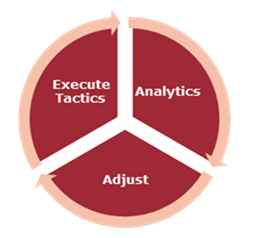There is no doubt digital marketing is a critical component within today’s business development efforts.
But if you are making investments in online marketing tactics, how do you gauge how well they are performing?
The good news is you don’t have to fly blind since real-time data, along with analytics tools, are readily available to keep track of results.
Online Marketing Analytics 101
 Online Marketing Analytics is about using insights gleaned from data about prospect behavior, how you are faring versus competitors, and the effectiveness of your online marketing tactics. These insights allow you to make course corrections to improve results.
Online Marketing Analytics is about using insights gleaned from data about prospect behavior, how you are faring versus competitors, and the effectiveness of your online marketing tactics. These insights allow you to make course corrections to improve results.
Analytics is a never-ending process. The market and competition don’t stand still; online marketing tactics must be continually measured and adjusted to adapt to changing realities.
Some examples of what you can learn through online marketing analytics are:
- Which marketing communications activities are driving people to your website?
- Which social media activities are driving visibility and inbound leads?
- Is your website being found when prospects search online?
- How many people opened your newsletter and clicked on the links?
- Are your online ads driving increased sales?
There are a never-ending number of key performance indicators (KPI’s) you can track through online marketing analytics. The key is to focus on the right metrics – and then make the requisite adjustments to improve performance. The goal is to be results oriented by focusing on outcomes, rather than “just doing things”.
The 5 Steps to Becoming Results Oriented
1. Identify and Confirm Business Objectives

Example: A business may want to double revenues for a particular product line over the next three years.
2. Establish Key Performance Indicator (KPI) Metrics
Key performance indicator metrics must be directly linked to business objectives.
There are two types of KPI’s – macro and micro.
Macro level KPI’s are related to overarching goals such as leads and conversions.
- Micro-level KPI’s concentrate on specific tactics – how they are performing and whether they are contributing to the achievement of the macro-level goals.
Once you know exactly what you need to measure, you can effectively gauge performance.
Example: A key performance indicator may be the number of inbound leads generated through the website or whether an online ad is generating sales.
3. Set Specific Targets

Analytics is all about “good” and “bad”. What is going well, and what is going poorly. You need to have specific targets in order to assess good and bad.
4. Implement Tools and Technologies
Implementing tools and technologies makes data-driven decision-making possible through the utilization of scorecards, dashboards, and seamless integrations with data sources.
Scorecards provide a high-level view of key performance indicators (KPIs), enabling marketers to track progress against goals and benchmarks in real-time.
Dashboards offer interactive visualizations that consolidate data from multiple sources, allowing teams to drill down into campaign performance, customer behavior, website metrics, etc.
Integrating analytics platforms with CRM systems, social media channels, and advertising networks ensures for a comprehensive view of marketing efforts, facilitating automated reporting and deeper insights.
These tools and technologies streamline data analysis, improve efficiency, and empower marketers to optimize tactics to increase visibility, prospect engagement and ultimately conversions.
5. Make Decisions

Testing is a Good Idea
The readily available access to real-time data makes the testing of online activities practical for any organization. Small and mid-sized businesses work with shoestring marketing budgets, so you want to make sure your limited funds are invested wisely. Testing to understand cause and effect increases the probability of achieving results and generating a positive ROI.
Marketing Analytics and Artificial Intelligence
AI is revolutionizing how data can be used to make more informaed decisions in a timely manner. By using summarization techniques, AI can process vast amounts of data from multiple channels, delivering concise insights about performance and emerging trends.
AI’s predictive capabilities give marketers a clear sense of how tactics and campaigns will perform, and offers recommendations regarding how to improve tactics.This allows businesses to be truly results driven.
The Bottom Line
Although measuring performance may seem daunting, it is crucial to understanding the impact of digital marketing and what actions must be taken to get better results.
You shouldn’t fly blind when it comes to online marketing. Timely data, along with analytical and reporting tools, are readily accessible to any business.
Make online marketing analytics part of your day-to-day activities to ensure your investments in digital marketing have a direct impact on revenue growth.
- How Google’s AI Mode and Deep Search Are Reshaping SEO - July 10, 2025
- CRM’s In the Age of the Digital Buyer - June 6, 2025
- Generate Sales Leads with Online Marketing - May 1, 2025

 Macro level KPI’s are related to overarching goals such as leads and conversions.
Macro level KPI’s are related to overarching goals such as leads and conversions.